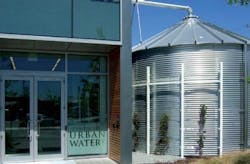Out of Sight, Out of Mind
Renovation of a wastewater system in Dresden and reconstruction of the Rhine Harbour in Strasbourg have taken advantage of trenchless technologies in a bid to minimise disruption to the local and visiting populations.
The Elbe River region in Dresden is home to 500,000 inhabitants who each consume an average of 100 litres of water per day. Including stormwater, around 60 million m³ of wastewater are collected and then treated in the Dresden-Kaditz treatment plant per year. This accumulates to 120,000m³ of wastewater on a dry day. A quick and safe discharge of this big quantity of water requires a well functioning sewer system. Parts of the network are, however, over 100 years old and in constant need of repair and renovation. Since 1990 Stadtentwässerung Dresden GmbH, a subsidiary of the Saxon State Capital Dresden and GELSENWASSER AG, has invested €575 million in the renovation and expansion of the sewer network as well as water treatment plants.
The sewer mains were built over the last three decades of the 19th century. They run perpendicularly towards the Elbe and lead into collectors running alongside the river by the old and new town side. A survey showed that the so-called "Old Town Collector", made out of compressed concrete on the left side of the Elbe, urgently needed to be renovated. There were several signs of damage and a safe load capacity was no longer guaranteed. The section to be renovated spans over 1.3km and runs through the old town quarter and along the left bank of the Elbe. Home to the Semper Opera House, the Zwinger Palace, the Old Masters Picture Gallery, the treasure chamber of the Electors and Kings of Saxony, Dresden attracts around seven million tourists per year.
The only possibility to ensure Dresden's visitors remained undisturbed was to renovate the old sewer by trenchless means, namely relining. Compared to the open trench installation, the construction time as well as inconveniences regarding traffic flow and tourism can be kept to a minimum. The renovation costs for the sewage collector amount to around €7 million and construction works are set to be completed by the second half of 2010.
During construction works, the wastewater is diverted with a siphon pipe DN 1200 with a maximal flow rate of up to 1900 l/s. It runs on supports underneath the quay so as not to hamper the Saxon steamboats and above the quay wall beyond the Augustus Bridge. Artist Christian Gerdorf also helped Stadtentwässerung Dresden GmbH turn the sheathing of the provisional pipeline into a further tourist attraction.
After a thorough comparison the company opted for the HOBAS NC Line alongside other brands. With a k-value of less than 0.01 mm, the inner surface of the profiles proved to be a decisive advantage, meeting hydraulic requirements despite the slightly reduced diameter of the relining profiles. During preparations technical details were arranged with the planning office ACI-Aquaprojekt Consult and contractors Insituform Rohrsanierungstechniken GmbH and Heinrich Lauber GmbH in Coswig. The contractors paid particular attention to meeting the required quality parameters and to technological processes.
The existing pipe was first inspected and calibrated by laser scan and then manually with a mold to determine the exact outer dimensions of the future profiles. This was necessary to maximise the capacity of the new sewer while ensuring an easy installation. A precise plan including standard and short profiles and some with special oblique couplings was worked out.
(Above) Water sight: local artist Christian Gerdorf helped Stadtentwässerung Dresden GmbH turn the sheathing of the provisional pipeline into a further tourist attraction.
The static design is based on the rules and regulations M-127 T2 set by the ATV-DVWK (Abwassertechnische Vereinbarung – Agreement regarding Wastewater - and Deutscher Verband für Wasserwirtschaft und Kulturbau – the German Association for Water Management and Land Improvement). As the condition of the existing sewer is categorised class III, the calculations by LGA Nürnberg/Ingsoft GmbH were carried out with due consideration of the special geometry and the grouting procedure. Here it proved advantageous that HOBAS NC Line Profiles are manufactured with definable wall thicknesses, which keeps statically inconvenient imperfections to a minimum.
Since the profiles are produced at the factory, there is no subsequent shrinkage that could lead to circular cracks. Using this method, deformations due to inconsistencies in the old sewer, are not transferred to the new pipe. This wouldn't be the case with cured-in-place relining methods.
Special requirements were set to the quality of the NC Line Profiles. The production facility was audited for production approval. This was done for inspection, to check the quality assurance system and to see if standards were kept according to specifications. The supplied product was analysed in addition to the assessment. The engineering office Siebert und Knippschild therefore took specimens from the construction site and checked them for given parameters.
In two separate construction stages a 520m and a 320m stretch of HOBAS NC Line Profiles were installed with internal dimensions of 2157 x 2129 mm and 2242 x 2195 mm. The 2.35m long HOBAS Profiles were lowered into the assembly pits by crane. With a specially built transportation vehicle the profiles were fed into the old sewer and assembled. This method ensured an optimal pipe transportation and installation. Finally, the new line was secured against uplift and the space between the old and new structure was grouted in accordance with the static calculations.
Once the project is finalised, the collector will be completely restored and should last for the next 100 years even during floods. Morevoer, the millions of tourist visiting each year barely notice the works going on beneath their feet. Pipe storage and assembly pits that are set in relatively large intervals are the only evidence of the ongoing activities under the streets of Dresden's Old Town.
It is not just in Germany where trenchless technology is proving its worth across Europe.
The reconstruction of the sewer main for the Rhine Harbour of Strasbourg, France, was a model example of the complementary nature of open-dig and trenchless installation. Where the working space would have been insufficient, rehabilitation was carried out by sliplining prefabricated GRP NC Line panels. Wherever a trench was feasible, CC-GRP Pipes were laid in an excavated trench which was prepared in accordance with pipe installation standards and as the depth required.
The project, coordinated by the Water and Sanitation Division of the Urban Community of Strasbourg, involved the renovation of an egg shaped main dimensioned 1,400mm x 1,900mm that functions as a combined sewer for domestic and industrial effluents. A 980m DN 1500 CC-GRP pipe section was lowered into a trench with a depth varying between 3m and 9m. Over a stretch of 550m the existing egg shaped structure was sliplined using GRP NC Line panels with an internal dimension of 1230mm x 1660mm. All pipe material was supplied by HOBAS.
"The performance of the two methods and the pipe material had to be taken into account while keeping environmental impacts to a minimum. Trenchless installation enabled the industrial roadway to remain open for use and us to comply with budget and safety considerations", explains Marc Hunsinger, head of the CUS Water and Sanitation Networks department. This project was coordinated by a consortium where SMCE Réha was responsible for the trenchless section and EJL Alsace for the open-dig section.
The sewer main that was relined has a curved section and therefore required the use of panels in different lengths varying from 1m to 2.35m. These were inserted in the main with the help of a trolley and fitted together with a hydraulic jack. This was followed with the panels being held in place with wooden wedges and finally fixed by grouting the annulus.
For the structural rehabilitation, the 25mm thick NC Line walls have been calculated to ensure the optimal performance of the new line. This system is designed to not only transfer vertical loads (ground and heavy industrial traffic) but above all withstand aggressive substances from effluents from agronomical industrial plants with pH levels ranging from 1 to 10. The sewer's leak tightness is guaranteed by EPDM rubber seal integrated in each PN 1 connection.
"The structure of the masonry sewer was very weak due to constant heavy loads from lorries. Furthermore, its crown has suffered because of corrosive exhaust emissions," says Laurent Gerber, managing director of SMCE Réha.
The relined sections with GRP panels show high structural and mechanical strength, the flow rate is now considerably higher, and the new material is corrosion as well as abrasion resistant guaranteeing durability for at least 50 years.
Gerber adds: "Trenchless rehabilitation was a good alternative installation method that allowed us to keep existing trees and moreover ensured open access to the industries of Strasbourg's harbour. The sliplining only required three access pits over the 550m stretch that was rehabilitated and therefore kept disruptions of a strongly frequented road to a minimum."
The simultaneously excavated section required special equipment, as emphasised by Jean-Claude Bouvard, director of the EJL Fergersheim branch: "We deployed heavy machinery and a lot of manpower for the installation of the new sewer. For the maximal depth of 9m we used high tonnage compact excavator types 944, 934 and 924 from Liebherr as well as heavy-duty double slide trench shields. The DN 1500 CC-GRP HOBAS Pipes weigh only 365kg per meter, each standard unit being 6m long. The comparably light weight at the given diameter, the pipe length and mounted push-to-fit joints made handling easy."
Completing the system and in addition to the pipes, fifteen prefabricated HOBAS CC-GRP DN 1500 x DN 1000 tangential manholes have been installed for the open trench section. These special components are equipped with GRP couplings which connect to the standard centrifugally cast GRP pipes. WWi
Author's note:More information on Hobas and trenchless technologies can be found at: www.hobas.com.
More Water & WasteWater International Current Issue Articles
More Water & WasteWater International Archives Issue Articles



